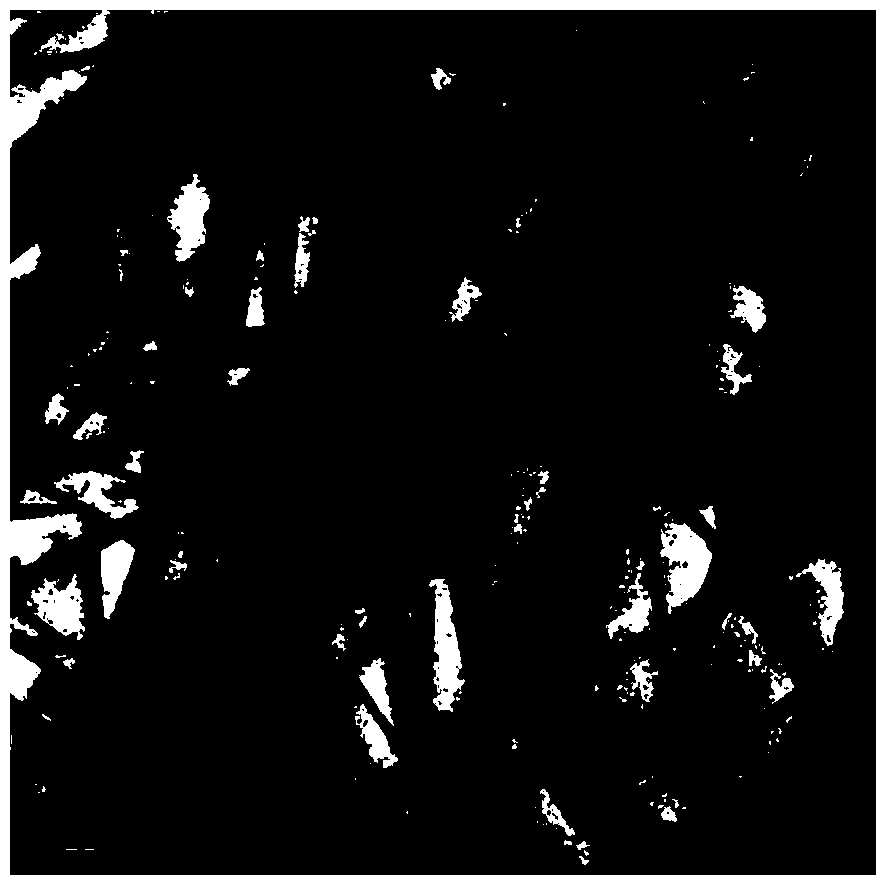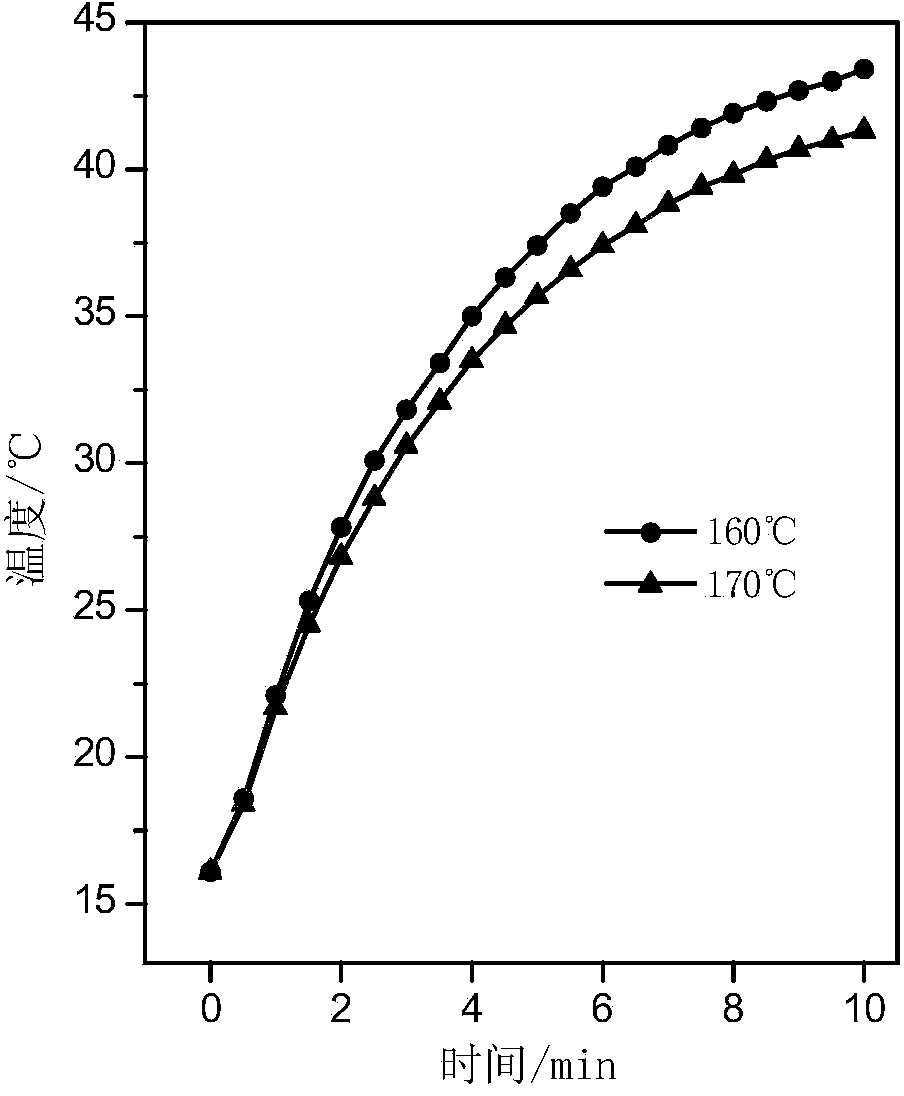Preparation method of copper sulfide nanowire
A copper sulfide and nanowire technology, applied in copper sulfide, nanotechnology, nanotechnology and other directions, can solve problems such as unfavorable large-scale synthesis, inability to synthesize in one step, cumbersome operation process, etc., achieving simple synthesis method and reaction device, and green reaction process. , the effect of cleaning the reaction process
- Summary
- Abstract
- Description
- Claims
- Application Information
AI Technical Summary
Problems solved by technology
Method used
Image
Examples
Embodiment 1
[0025] (1) In a 50ml three-necked bottle, weigh 0.5mmol CuCl 2 2H 2 O and 10ml oleylamine, pass into N 2 Protected, heated to 160°C with stirring, and then kept at constant temperature for 1h.
[0026] (2) Take another 5ml of oleylamine in a test tube, add 0.5mmol (C2H5)2NCSSNa·3H2O(SDEDTC), stir and dissolve at 120°C.
[0027] (3) Inject the solution in (2) into (1) through a syringe pump at a rate of 30ml / h, and react at a constant temperature for 1h.
[0028] (4) Cool the obtained product to 60°C, centrifuge in a 10ml centrifuge tube, wash twice with cyclohexane, and finally disperse in 10ml chloroform, which is the hydrophobic product.
[0029] (5) Use 2ml of a chloroform solution containing 20mg of polyethylene glycol monomethyl etherified-1,2-distearate-3-phosphatidylethanolamine (SDEDTC) and 1ml of the hydrophobic product in (4), after stirring for 2 hours, put The obtained product was placed in a rotary evaporator, vacuum-dried and spin-dried at room temperature, a...
Embodiment 2
[0033] (1) In a 50ml three-necked bottle, weigh 0.5mmol CuCl 2 2H 2 O and 10ml oleylamine, pass into N 2 Protected, heated to 170°C while stirring, and then kept at constant temperature for 1h.
[0034] (2) Take another 5ml of oleylamine in a test tube, add 0.5mmol (C 2 h 5 ) 2 NCSSNa·3H 2 O(SDEDTC), stirred and dissolved at 120°C.
[0035] (3) Inject the solution in (2) into (1) through a syringe pump at a rate of 30ml / h, and react at a constant temperature for 1h.
[0036] (4) Cool the obtained product to 60°C, centrifuge in a 10ml centrifuge tube, wash twice with cyclohexane, and finally disperse in 10ml chloroform, which is the hydrophobic product.
[0037] (5) Use 2ml of chloroform solution containing 20mg of polyethylene glycol monomethyl etherified-1,2-distearate-3-phosphatidylethanolamine (DSPE-PEG) and 1ml of the hydrophobic product in (4), after stirring for 2h , the obtained product was placed in a rotary evaporator, vacuum-dried and spin-dried at room tempe...
Embodiment 3
[0041] (1) In a 50ml three-necked bottle, weigh 0.5mmol CuCl 2 2H 2 O and 10ml oleylamine, pass into N 2 Protected, heated to 160°C while stirring, and then kept at constant temperature for 30min.
[0042] (2) Take another 5ml of oleylamine in a test tube, add 0.5mmol (C 2 h 5 ) 2 NCSSNa·3H 2 O(SDEDTC), stirred and dissolved at 120°C.
[0043] (3) Inject the solution in (2) into (1) at a rate of 30ml / h through a syringe pump and react at a constant temperature for 1.5h.
[0044] (4) Cool the obtained product to 60°C, centrifuge in a 10ml centrifuge tube, wash twice with cyclohexane, and finally disperse in 10ml chloroform, which is the hydrophobic product.
[0045] (5) Use 2ml of chloroform solution containing 20mg of polyethylene glycol monomethyl etherified-1,2-distearate-3-phosphatidylethanolamine (DSPE-PEG) and 1ml of the hydrophobic product in (4), after stirring for 2h , the obtained product was placed in a rotary evaporator, vacuum-dried and spin-dried at room t...
PUM
 Login to View More
Login to View More Abstract
Description
Claims
Application Information
 Login to View More
Login to View More - R&D
- Intellectual Property
- Life Sciences
- Materials
- Tech Scout
- Unparalleled Data Quality
- Higher Quality Content
- 60% Fewer Hallucinations
Browse by: Latest US Patents, China's latest patents, Technical Efficacy Thesaurus, Application Domain, Technology Topic, Popular Technical Reports.
© 2025 PatSnap. All rights reserved.Legal|Privacy policy|Modern Slavery Act Transparency Statement|Sitemap|About US| Contact US: help@patsnap.com



